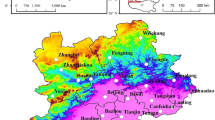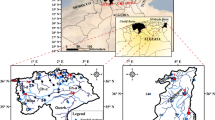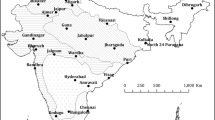Abstract
This study examines the temporal patterns of precipitation and the influence of large-scale climate anomalies in the Pearl River basin (South China), with particular focus on sub-basin scale. Three popular data analysis techniques are employed: (1) wavelet analysis; (2) principal component analysis (PCA); and (3) rank correlation method. With due consideration to hydrologic factors, water resources activities, and large-scale climate data, the entire basin is divided into ten sub-basins and the analysis is performed on monthly data. The wavelet analysis reveals discernible differences in temporal scales of fluctuation embedded in the monthly precipitation anomalies over the basin. The PCA delineates three coherent regions exhibiting similar distribution of variability across scales. Analysis of linkages between precipitation and teleconnection patterns using cross-wavelet transform and wavelet coherence reveals that the dominant variabilities of precipitation are essentially depicted by the Indian Ocean Dipole (IOD), especially for the central and eastern part of the Pearl River basin. On the influence of El Niño-Southern Oscillation (ENSO) signal on precipitation, more significant correlation is detected for the eastern part of the basin, long-term relationships (within 4–8 years band) are found for the western part of the basin, while the central part seems to be acting as a transition zone. Rank correlations of scale-averaged wavelet power between regional precipitation and climate indices for the dominant low-frequency variability band (0.84–8.40 years) provide further support to the different precipitation-climate relationships for different regions over the basin. The present results provide valuable information towards: (1) improving predictions of extreme hydroclimatic events in the Pearl River basin, based on their relationships with IOD or ENSO; and (2) devising better adaptation and mitigation strategies under a future changing climate.










Similar content being viewed by others
References
Aksoy H (2001) Storage capacity for river reservoirs by wavelet-based generation of sequent-peak algorithm. Water Resour Manag 15(6):423–437
Ashok K, Guan Z, Yamagata T (2003) Influence of the Indian Ocean dipole on the Australian winter rainfall. Geophys Res Lett 30:1821. doi:10.1029/2003GL017926
Asquith D (2008) Learning to live with statistics: from concept to practice. Lynne Rienner, Boulder 379 p
Bayazit M, Aksoy H (2001) Using wavelets for data generation. J Appl Stat 28(2):157–166
Bayazit M, Önöz B, Aksoy H (2001) Nonparametric streamflow simulation by wavelet or Fourier analysis. Hydrol Sci J 46(4):623–634
Chen J, Kumar P (2002) Role of terrestrial memory in modulating ENSO impacts in North America. J Clim 15(24):3569–3585
Chen YQ, Zhang Q, Chen XH, Wang P (2012) Multiscale variability of streamflow changes in the Pearl River basin, China. Stoch Environ Res Risk Assess 26:235–246
Compagnucci RH, Blanco SA, Figliola MA, Jacovkis PM (2000) Variability in subtropical Andean Argentinean Atuel river; a wavelet approach. Environmetrics 11:251–269
Coulibaly P, Burn DH (2004) Wavelet analysis of variability in annual Canadian streamflows. Water Resour Res 40:W03105. doi:10.1029/2003WR002667
Cui WZ, Chen J, Wu YP, Wu YD (2007) An overview of water resources management of the Pearl River. Water Sci Technol Water Supply 7(2):101–113
Daubechies I (1988) Orthonormal bases of compactly supported wavelets. Commun Pure Appl Math XLI:901–996
Ding YH, Chan JCL (2005) The east Asian summer monsoon: an overview. Meteorol Atmos Phys 89:117–142
Ding Y, Wang Z, Sun Y (2008) Inter-decadal variation of the summer precipitation in East China and its association with decreasing Asian summer monsoon Part I: Observed evidences. Int J Climatol 28:1139–1161
Dong DH (2006) Mitigation to the floods/droughts from the viewpoints of extreme precipitation in the Pearl River (in Chinese). Pearl River 5:33–34
Farge M (1992) Wavelet transforms and their applications to turbulence. Annu Rev Fluid Mech 24:395–457
Feng S, Hu Q, Qian WH (2004) Quality control of daily meteorological data in China, 1951–2000: a new dataset. Int J Climatol 24:853–870
Fischer T, Gemmer M, Liu L, Jiang T (2012) Change-points in climate extremes in the Zhujiang River Basin, South China, 1961-2007. Clim Change. doi:10.1007/s10584-011-0123-8
Gan TY, Gobena AK, Wang Q (2007) Precipitation of southwestern Canada: wavelet, scaling, multifractal analysis, and teleconnection to climate anomalies. J Geophys Res 112:D10110. doi:10.1029/2006JD007157
Gemmer M, Fischer T, Su B, Liu LL (2011) Trends of precipitation extremes in the Zhujiang River Basin, South China. J Clim 24:750–761
Gibson JK, Kållberg P, Uppala S, Hernandez A, Nomura A, Serrano E (1999) ERA-15 description (Version 2). ECMWF reanalysis project report series, no. 1, ECMWF, 73 p
Grinsted A, Moore JC, Jevrejeva S (2004) Application of the cross wavelet transform and wavelet coherence to geophysical time series. Nonlinear Process Geophys 11:561–566
Guan Z, Yamagata T (2003) The unusual summer of 1994 in East Asia: IOD teleconnections. Geophys Res Lett 30(10):1544. doi:10.1029/2002GL016831
Hoskins BJ (2003) Atmospheric processes and observations. Phil Trans R Soc Lond A 361:1945–1960
Jackson JE (1991) A user’s guide to principal components. Wiley, New York 569 p
Jayawardena AW, Xu PC, Li WK (2009) Rainfall data simulation by hidden Markov model and discrete wavelet transformation. Stoch Environ Res Risk Assess 23:863–877
Kumar P (1996) Role of coherent structure in the stochastic dynamic variability of precipitation. J Geophys Res 101(26):393–404
Kumar P, Foufoula-Georgiou E (1997) Wavelet analysis for geophysical applications. Rev Geophys 35(4):385–412
Labat D (2010a) Cross wavelet analyses of annual continental freshwater discharge and selected climate indices. J Hydrol 385:269–278
Labat D (2010b) Wavelet analyses in hydrology. In: Sivakumar B, Berndtsson R (eds) Advances in data-based approaches for hydrologic modeling and forecasting. World Scientific Publishing Company, Singapore, pp 371–410
Labat D, Ababou R, Mangin A (2000) Rainfall-runoff relations for karstic springs. Part II: continuous wavelet and discrete orthogonal multiresolution analysis. J Hydrol 238:149–178
Li F, Wang HJ (2012) Predictability of the East Asian Winter Monsoon interannual variability as indicated by the DEMETER CGCMS. Adv Atmos Sci 29(3):441–454
Li CY, Zhou W (2012) Changes in western Pacific tropical cyclones associated with the El Nino-southern oscillation cycle. J Clim. doi:10.1175/JCLI-D-11-00430.1
Lott N, Ross D, Sittel M (1997) The winter of 96-97 West Coast flooding. Res Customer Serv Group Tech Rep 97-01, 23 p, Natl Clim Data Cent, Asheville
Luo Y, Liu S, Fu SL, Liu JS, Wang GQ, Zhou GY (2008) Trends of precipitation in North River basin, Guangdong Province, China. Hydrol Process 22(13):2377–2386. doi:10.1002/hyp.6801
Mallat S (1989) A theory for multiresolution signal decomposition: the wavelet representation. IEEE Tran Pattern Anal Mach Intel 11(7):674–693
Mattin-vide J (2004) Spatial distribution of a daily precipitation concentration index in Peninsular Spain. Int J Climatol 24:959–971
Milly PCD, Wetherald RT (2002) Macroscale water fluxes, 3, Effects of land processes on variability of monthly river discharge. Water Resour Res 38:1235. doi:10.1029/2001WR000761
Mishra AK, Özger M, Singh VP (2011) Wet and dry spell analysis of Global Climate Model-generated precipitation using power laws and wavelet transforms. Stoch Environ Res Risk Assess 25:517–535
Niu J (2010) A comprehensive analysis of terrestrial hydrological processes over the Pearl River basin in South China. Ph.D. thesis, 202 p, University of Hong Kong, Hong Kong
Niu J, Chen J (2008) Application of VIC and routing scheme to Pearl River basin in South China. Adv Water Resour Hydraul Eng I:72–76. doi:10.1007/978-3-540-89465-0_14
Niu J, Chen J (2010) Terrestrial hydrological features of the Pearl River basin in South China. J Hydro-Environ Res 4:279–288. doi:10.1016/j.jher.2010.04.016
Pearl River Hydraulic Research Institute (2007) Drought monitor and assessment reports for the Pearl River basin using remote sensing. Pearl River Hydraulic Research Institute, Guangzhou, 60 p (in Chinese)
Pearl River Water Resource Commission (2005) Pearl Rive flood prevention handbook. Pearl River Water Resource Commission, Guangzhou, 150 p (in Chinese)
Ralph TJ, Hesse PP (2010) Downstream hydrogeomorphic changes along the Macquarie River, southeastern Australia, leading to channel breakdown and floodplain wetlands. Geomorphology 118:48–64
Richman MB (1986) Rotation of principal components. J Clim 6:293–335
Ropelewski CF, Halpert MS (1987) Global and regional scale precipitation patterns associated with the El Niño-Southern Oscillation. Mon Weather Rev 115:1606–1626
Saco P, Kumar P (2000) Coherent modes in multiscale variability of streamflow over the United States. Water Resour Res 36(4):1049–1067
Saji NH, Goswami BN, Vinayachandran PN, Yamagata T (1999) A dipole mode in the tropical Indian Ocean. Nature 401:360–363
Sivakumar B, Berndtsson R (eds) (2010) Advances in data-based approaches for hydrologic modeling and forecasting. World Scientific Publishing Company, Singapore
Smith LC, Turcotte D, Isacks BL (1998) Stream flow characterization and feature detection using a discrete wavelet transform. Hydrol Process 12:233–249
Tillinger D, Gordon AL (2009) Fifty years of Indonesian through flow. J Clim 22(23):6342–6355
Torrence C, Compo GP (1998) A practical guide to wavelet analysis. Bull Am Meteorol Soc 79(1):62–78
Torrence C, Webster PJ (1999) Interdecadal changes in the ENSO-Monsoon system. J Clim 12:2679–2690
Trenberth KE, Stepaniak DP (2001) Indices of El Niño evolution. J Clim 14:1697–1701
Ünal NE, Aksoy H, Akar T (2004) Annual and monthly rainfall data generation schemes. Stoch Environ Res Risk Assess 18:245–257
Wang W, Chen X, Shi P, van Gelder PHAJM (2008) Detecting changes in extreme precipitation and extreme streamflow in the East River Basin in southern China. Hydrol Earth Syst Sci 12:207–221
Wilks DS (1995) Statistical methods in the atmospheric sciences. Academic Press, San Diego, 467 p
Yang T, Shao QX, Hao ZC, Chen X, Zhang ZX, Xu CY, Sun LM (2010) Regional frequency analysis and spatio-temporal pattern characterization of rainfall extremes in the Pearl River Basin, China. J Hydrol 380:386–405
Yu S, Shi X, Lin X (2009) Interannual variation of East Asian summer monsoon and its impacts on general circulation and precipitation. J Geophys Res 19:67–80
Zhang Q, Xu CY, Jiang T, Wu YJ (2007) Possible influence of ENSO on annual maximum streamflow of Yangtze River, China. J Hydrol 333:265–274
Zhang Q, Xu CY, Becker S, Zhang ZX, Chen YQ, Coulibaly M (2009a) Trends and abrupt changes of precipitation maxima extremes in the Pearl River basin, China. Atmos Sci Lett 10:132–144
Zhang Q, Xu CY, Cemmer M, Chen YQ, Liu CL (2009b) Changing properties of precipitation concentration in the Pearl River basin, China. Stoch Environ Res Risk Assess 23:377–385
Zhang Q, Xu CY, Zhang ZX (2009c) Observed changes of drought/wetness episodes in the Pearl River basin, China, using the standardized precipitation index and aridity index. Theor Appl Climatol 98:89–99
Zhang Q, Xu CY, Zhang ZX, Chen YQ (2010) Changes of atmospheric water vapor budget in the Pearl River basin and possible implications for hydrological cycle. Theor Appl Climatol 102:185–195
Zhang Q, Chen YQ, Chen XH, Li JF (2011a) Copula-based analysis of hydrological extremes and implications of hydrological behaviors in the Pearl River basin, China. J Hydrol Eng 16(7):598–607
Zhang Q, Xu CY, Chen YQ, Ren LL (2011b) Comparison of evapotranspiration variations between the Yellow River and Pearl River basin, China. Stoch Environ Res Risk Assess 25:139–150
Zhang Q, Singh VP, Peng JT, Chen YQ (2012a) Spatial-temporal changes of precipitation structure across the Pearl River basin, China. J Hydrol 440–441:113–122
Zhang Q, Xiao MZ, Singh VP, Chen XH (2012b) Copula-based risk evaluation of droughts across the Pearl River basin, China. Theor Appl Climatol. doi:10.1007/s00704-012-0656-4
Zhou LT, Tam F, Zhou W, Chan JCL (2010) Influence of South China Sea SST and the ENSO on winter rainfall over South China. Adv Atmos Sci 27:832–844
Zhou W, Chen W, Wang DX (2012) The implications of ENSO signal for South China monsoon climate. Aquat Ecosyst Health Manage 15:14–19
Acknowledgments
This research was supported by the Hong Kong RGC GRF project (HKU 7117/06E), and PPR project (HKU 7022-PPR-2). The author is grateful to Dr. Ji Chen for the earlier suggestions on the method selection. The author would like to thank the two anonymous reviewers for their valuable comments and suggestions, which resulted in a more accurate and complete presentation of the work.
Author information
Authors and Affiliations
Corresponding author
Rights and permissions
About this article
Cite this article
Niu, J. Precipitation in the Pearl River basin, South China: scaling, regional patterns, and influence of large-scale climate anomalies. Stoch Environ Res Risk Assess 27, 1253–1268 (2013). https://doi.org/10.1007/s00477-012-0661-2
Published:
Issue Date:
DOI: https://doi.org/10.1007/s00477-012-0661-2




